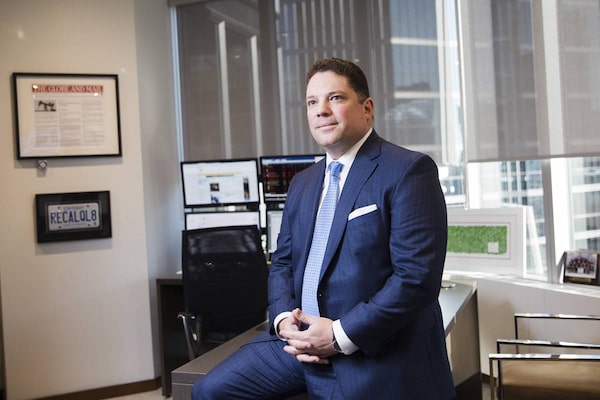
‘Transparency on investment issues is becoming more important,’ says Darren Coleman, a Toronto-based portfolio manager and author of a new book on financial management called Recalculating: Find Financial Success and Never Feel Lost Again.Michelle Siu/The Globe and Mail
Investors may know a lot about the virtues of exchange-traded funds, but for some, the fees can still be a mystery.
"Transparency on investment issues is becoming more important," says Darren Coleman, a Toronto-based portfolio manager and author of a new book on financial management called Recalculating: Find Financial Success and Never Feel Lost Again.
The general disclosure rules for investment fees have become more explicit since 2016, under an initiative called CRM2 (which stands for Client Relationship Model Phase 2), mandated by the Investment Industry Regulatory Organization of Canada (IIROC).
The new rules are helpful, says Mr. Coleman, who is also senior-vice president at Coleman Wealth, Raymond James Ltd. in Toronto.
"For many investors, this may be the first time they've actually noticed the dollar amount of fees they pay to have their investments managed," Mr. Coleman says.
Exactly what do the fees investors pay for ETFs represent, though? There are several aspects to consider, says Dan Bortolotti, associate portfolio manager at PWL Capital Inc. in Toronto.
The management expense ratio (MER) is the most obvious place to begin understanding the total cost of an ETF, Mr. Bortolotti says.
"The MER is made up of the fund's management fee, plus a couple of extra basis points for taxes," he explains. Typically, investors in Canada can expect that the MER for their ETFs will be 10 per cent higher than the management fee. (So if the management fee is 0.2 per cent, the MER should be about 0.22 per cent.)
"Most ETF providers include both the management fee and the MER on their websites," Mr. Bortolotti says.
Pauline Shum Nolan, professor of finance at York University's Schulich School of Business and CEO and co-founder of PW Portfolio Analytics, says, "I go directly to the websites of my investments to find out the fees. I simply Google the investment and look at their fact sheet."
Fees can also sometimes be found on online trading platforms, but not always.
"For the one I use, I don't get that information so I have to go directly to the ETF website," Dr. Shum Nolan says.
The other major element of ETF fees to note is the trading fee, Mr. Bortolotti says. Most online brokerages charge about $10 per trade, though some independents have lower commissions, and a few offer commission-free ETFs.
It may not sound like much, but, "if you trade frequently, this is certainly something to consider," Mr. Bortolotti says.
"Remember that if you're paying $10 per trade, that's 1 per cent on a $1,000 purchase, which is too high."
Trading fees are the main reason ETFs are not well suited to small accounts and don't work well for investors who make regular monthly contributions to their portfolios, Mr. Bortolotti says.
ETFs that are purchased through a registered financial advisor can also require investors to pay a "trailer" fee for management of the fund. "This is often about 1 per cent annually," Mr. Coleman says.
While this has always been disclosed as a percentage fee in fund prospectuses, 2017 is the first year that clients receive statements showing the actual dollar amounts for fees they paid, he adds.
Yves Rebetez, managing director of ETF Insight, noted on the Morningstar website that about 90 ETFs in Canada have advisor or trailer fees. This is out of at total of 495 ETFs with $133.8-billion in assets under management (as of early September, 2017, according to the Canadian ETF Association).
He notes that a study commissioned by the Ontario Securities Commission concluded that trailer fees inhibit the performance of investments.
What to watch
Portfolio manager Mr. Bortolotti says there are other fees to look at when reviewing your ETF. These include:
The bid-ask spread
The difference between the price you pay to buy a share and the amount you receive when you sell one. "This can be as little as one cent for large, liquid ETFs. But for some other funds it can be three or four cents, or occasionally more. This isn't a huge concern if you are a long-term, buy-and-hold investor, but it's very important if you trade frequently," Mr. Bortolotti says.
The trading expense ratio (TER)
An additional cost not included in the MER. It includes the transaction costs within the fund itself. With large index ETFs (which don't do a lot of trading) this is usually trivial. But in some more active ETFs, it can be quite significant.
Currency conversion costs
These will be charged if you are buying U.S. ETFs, unless you already have U.S. dollars in your account. "If you buy U.S.-listed ETFs using Canadian dollars, the currency will be automatically exchanged at your brokerage's retail rate, which is usually very unfavourable," Mr. Bortolotti says.